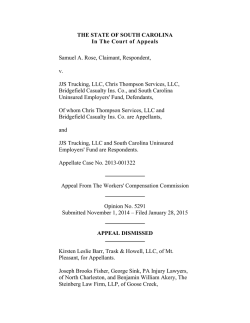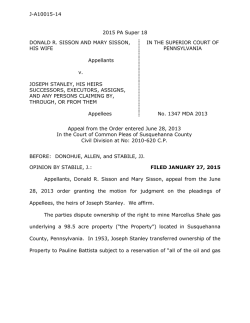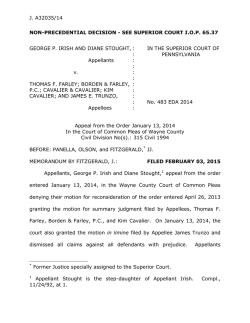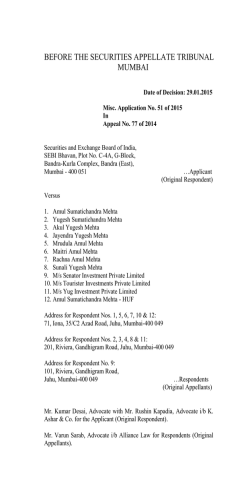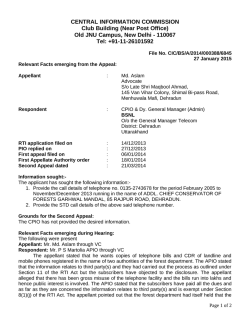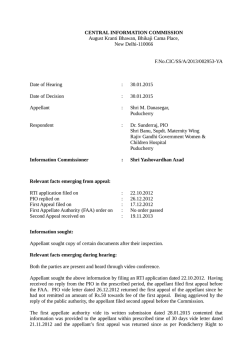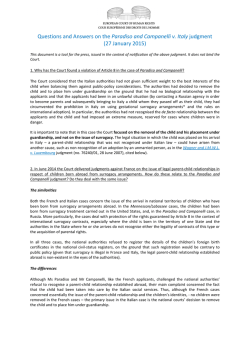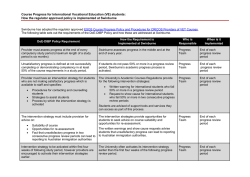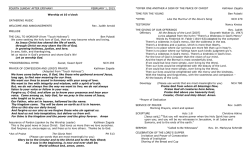
j-a24034-14 non-precedential decision - see
J-A24034-14 NON-PRECEDENTIAL DECISION - SEE SUPERIOR COURT I.O.P. 65.37 JOHN VALENTINO AND MARY CLARE VALENTINO, H/W AND JEEL CORPORATION, IN THE SUPERIOR COURT OF PENNSYLVANIA Appellants v. HARLEYSVILLE PREFERRED INSURANCE COMPANY AND SCOTT RITTER, IND. & T/A SER BUILDING ASSOCIATES, INC. AND STABLE CONTRACTING A/K/A STABLE ROOFING AND DANIEL BEEBIE, IND. & T/A RESQUE, Appellees No. 360 EDA 2014 Appeal from the Order Dated December 16, 2013 in the Court of Common Pleas of Philadelphia County Civil Division at No.: February Term, 2012, No. 3608 BEFORE: GANTMAN, P.J., BENDER, P.J.E., and PLATT, J.* MEMORANDUM BY PLATT, J.: FILED FEBRUARY 03, 2015 Appellants, John and Mary Clare Valentino, husband and wife, and Jeel Corporation, (which they own), appeal from the orders granting summary judgment in favor of Appellees, Harleysville Preferred Insurance Company, Scott Ritter t/a SER Building Associates, Inc. and Daniel Beebie, individually ____________________________________________ * Retired Senior Judge assigned to the Superior Court. J-A24034-14 and t/a Resque.1 Appellants assert genuine issues of material fact and trial court abuse of discretion. We affirm. This is a hybrid case combining an insurance coverage dispute claiming damage to a commercial building, and claims of negligent performance against roofing contractors for the same damage. There is a voluminous record, but the central underlying disputes are whether the roofing contractors, Ritter and Beebie, were negligent, in breach of contract, causing damage from rain seepage, and whether this damage constituted a covered ____________________________________________ 1 On December 16, 2013, after a bench trial, the court entered a defense verdict for Stable Contracting, a sole proprietorship of Christopher Maher, and the last remaining defendant, resolving all claims for all parties. Notably, the trial court found the testimony of John Valentino to be “incredible” and the damages claimed “so grotesquely inflated as to completely undermine his testimony.” (Order, 12/16/13, at 1 n.1). Appellants timely appealed from the verdict after the bench trial on December 16, 2013, as well as the previous grants of summary judgment. (See Notice of Appeal, 12/30/13). However, they did not file a post-trial motion following the verdict. This Court filed a rule to show cause order, questioning whether issues related to the trial were waived for failure to file a timely post-trial motion. Counsel for Appellants has conceded that no issues challenging the bench trial verdict were preserved for appeal, but maintains that the issues from the grants of summary judgment were properly preserved. (See “Memorandum,” 2/26/14, at 2-3). Accordingly, all issues related to the bench trial verdict are waived. See Pa.R.C.P. 227.1; Chalkey v. Roush, 805 A.2d 491, 496 (Pa. 2002) (“Under Rule 227.1, a party must file post-trial motions at the conclusion of a trial in any type of action in order to preserve claims that the party wishes to raise on appeal”). Appellants fail to include the text of the orders appealed from in their brief. See Pa.R.A.P. 2111(a)(2); Pa.R.A.P. 2115(a). The orders are included in the Reproduced Record. -2- J-A24034-14 loss under the policy. We summarize only the facts most relevant to our review of the claims properly preserved and raised on appeal. Appellants allege that they (through Mr. Valentino) made an “oral handshake” agreement with Ritter, t/a SER Building Associates, to remove and repair (or replace) a roof on their non-compliant commercial property at 3001 Richmond Street, in Philadelphia, Pennsylvania.2 (See Appellants’ Brief, at 17; see also Deposition of John Valentino, 3/25/13, at 34). The building was used to store product in connection with Jeel’s retail appliance business. After making the preliminary arrangements, Mr. Valentino left for a two month trip to Arizona, from May to July, 2010. He asserts he discovered the damage in July of 2010, after his return. A month later, he made a claim under the policy, on August 18, 2010, designating that same date as the date of loss. Harleysville engaged a claims adjuster, and then retained a civil engineer, Gary Popolizio, to inspect the property. Mr. Popolizio produced a written report. (See Harleysville Preferred’s Motion for Summary Judgment, at Exhibit G, Report of Gary L. Popolizio, P.E., 4/09/11). Harleysville ____________________________________________ 2 The building had previously been cited for building code violations. (See Deposition of John Valentino, 3/25/13, at 15-16). -3- J-A24034-14 eventually paid policy limits for loss of contents,3 but denied further payment (for damages to the building) on the ground that the claim was not the result of a covered loss. On November 18, 2011, Harleysville issued a denial of coverage letter based on the Popolizio report and various cited exclusions and limitations in the policy. (See id. at Exhibit F, Letter from Mark Sworaski, Property Claims Supervisor, Harleysville Preferred, to Jeel Corporation, Attn: John Valentino, 11/18/11, at 1-3; see also Appellee Harleysville’s Brief, at 4). The letter, citing the Popolizio report, noted, inter alia, an aging building with a bulging brick wall, evidence of prior repairs, and long-term deterioration from multiple freeze-thaw cycles specifically excluded under the terms of the policy. The letter further noted policy exclusions for wear and tear, corrosion and other forms of deterioration, and for continuous or repeated seepage or leakage of water. The policy also excluded coverage for negligent work, including maintenance, repair, construction or renovation. Most notably, the policy excluded, in pertinent part, loss or damage to an interior from “rain . . . whether driven by wind or not” unless the building or structure first sustained damage from a “Covered Cause of Loss to its roof or walls through which the rain . . . enters.” (Trial Court Opinion, ____________________________________________ 3 Harleysville initially claimed its liability for damage to contents was limited to $32,000.00 under the policy. During litigation, Appellants’ counsel argued that a higher payment was due. Harleysville agreed and paid an additional amount for the contents claim. -4- J-A24034-14 8/05/13, at 2; (quoting Policy, Section I, 4(a), (5)(a)) (emphasis added); see also, inter alia, Appellee Harleysville’s Brief, at 4). Appellants sued.4 As noted by the trial court, at Mr. Valentino’s deposition, when asked about the source of the water which came into the building in July of 2010, he responded: “Rain.” “Just ordinary rain?” “Ordinary rain, God-given rain.” (Deposition of John Valentino, 3/25/13, at 76; see also Trial Ct. Op., 8/05/13, at 4). Harleysville and Ritter moved for summary judgment. The trial court granted the motions on August 5, 2013, in an order with accompanying opinion. (See Order, 8/05/13, at 1; see also Trial Ct. Op., 8/05/13, at 16). As to Harleysville, the trial court reasoned that the insurance claim fell under the provision which excluded coverage for water damage from rain, concluding that “[o]rdinary rain is not a covered loss under the policy.” (Trial Ct. Op., 8/05/13, at 4). ____________________________________________ 4 In addition to the claims addressed in this appeal, Appellants sought punitive damages for bad faith, and related claims. (See Appellants’ Amended Civil Action Complaint, at 5-6, Count II, ¶¶ 25-28). Appellants do not pursue these claims on appeal. Accordingly, we deem them abandoned. -5- J-A24034-14 Beebie, individually and t/a Resque, moved for summary judgment separately. The trial court granted Beebie’s motion on October 3, 2013, with no additional opinion. (See Order, 10/03/13). In granting summary judgment for Ritter (and later Beebie), the court reasoned that Appellants failed to prove their claim that contractor negligence caused the resultant damage. The trial court maintains that expert testimony was required to establish causation. (See Trial Ct. Op., 8/05/13, at 5; see also Order, 10/03/13 n.1). As previously noted, on December 16, 2013, the same trial judge rendered a defense verdict in the bench trial case against the remaining defendant, Stable Contracting a/k/a Stable Roofing (a sole proprietorship of Christopher Maher). (See Order, 12/16/13).5 Appellants timely appealed all three orders. (See Notice of Appeal, 12/30/13). The trial court did not order a statement of errors complained of on appeal. See Pennsylvania Rule of Appellate Procedure 1925(b). The trial court filed an opinion on February 10, 2014, incorporating by reference its opinion and order dated August 5, 2013, and order dated October 3, 2013.6 See Pa.R.A.P. 1925(a). ____________________________________________ 5 Mr. Maher represented himself and testified at the trial. 6 The trial court also asks this Court to quash the appeal from the bench trial verdict dated December 16, 2013 for failure to file post-trial motions. (See (Footnote Continued Next Page) -6- J-A24034-14 Appellants raise three questions on appeal: A. Whether the [t]rial [c]ourt’s determination that Appellee, Harleysville[,] was entitled to summary judgment because there is no coverage under the policy constituted an abuse of discretion where there are multiple issues of material fact suggesting that a preceding covered cause of loss occurred which would have afforded coverage for Appellants’ loss? B. Whether the [t]rial [c]ourt’s determination that Appellee, Scott Ritter T/A SER Building Associates was entitled to summary judgment was an abuse of discretion where the [c]ourt found that expert testimony was required to prove the link between Ritter’s breach of contract and the damages sustained by Appellants despite the fact that the competent evidence sufficiently made such a connection? C. Whether the [t]rial [c]ourt’s determination that Appellee, Daniel Beebie, individually and T/a [sic] Resque was entitled to summary judgment was an abuse of discretion where the [c]ourt found that expert testimony was required to prove the link between Beebie’s breach of contract and the damages sustained by Appellants despite the fact that the competent evidence sufficiently made such a connection? (Appellants’ Brief, at 3). Our review on an appeal from the grant of a motion for summary judgment is well-settled. A reviewing court may disturb the order of the trial court only where it is established that the court committed an error of law or abused its discretion. As with all questions of law, our review is plenary. In evaluating the trial court’s decision to enter summary judgment, we focus on the legal standard articulated in the summary judgment rule. Pa.R.C.P. 1035.2. The rule states that where there is no genuine issue of material fact and the moving party is entitled to relief as a matter of law, summary judgment may be entered. Where the non-moving party bears the burden (Footnote Continued) _______________________ Trial Court Opinion, 2/10/14, at 2). For the reasons already noted, this issue is now moot. (See n.3, supra). -7- J-A24034-14 of proof on an issue, he may not merely rely on his pleadings or answers in order to survive summary judgment. Failure of a non-moving party to adduce sufficient evidence on an issue essential to his case and on which it bears the burden of proof . . . establishes the entitlement of the moving party to judgment as a matter of law. Lastly, we will view the record in the light most favorable to the non-moving party, and all doubts as to the existence of a genuine issue of material fact must be resolved against the moving party. Murphy v. Duquesne University of the Holy Ghost, 777 A.2d 418, 429 (Pa. 2001) (citations and quotation marks omitted). Furthermore, [W]e apply the same standard as the trial court, reviewing all the evidence of record to determine whether there exists a genuine issue of material fact. . . . Only where there is no genuine issue as to any material fact and it is clear that the moving party is entitled to a judgment as a matter of law will summary judgment be entered. Motions for summary judgment necessarily and directly implicate the plaintiff’s proof of the elements of [his] cause of action. Summary judgment is proper if, after the completion of discovery relevant to the motion, including the production of expert reports, an adverse party who will bear the burden of proof at trial has failed to produce evidence of facts essential to the cause of action or defense which in a jury trial would require the issues to be submitted to a jury. Pa.R.C.P. 1035.2. Thus, a record that supports summary judgment will either (1) show the material facts are undisputed or (2) contain insufficient evidence of facts to make out a prima facie cause of action or defense and, therefore, there is no issue to be submitted to the jury. Upon appellate review, we are not bound by the trial court’s conclusions of law, but may reach our own conclusions. The appellate Court may disturb the trial court’s order only upon an error of law or an abuse of discretion. Judicial discretion requires action in conformity with law on facts and circumstances before the trial court after hearing and consideration. Consequently, the court abuses its discretion if, in resolving the issue for decision, it misapplies the law or exercises its discretion in a manner lacking -8- J-A24034-14 reason. Similarly, the trial court abuses its discretion if it does not follow legal procedure. Where the discretion exercised by the trial court is challenged on appeal, the party bringing the challenge bears a heavy burden. [I]t is not sufficient to persuade the appellate court that it might have reached a different conclusion if . . . charged with the duty imposed on the court below; it is necessary to go further and show an abuse of the discretionary power. An abuse of discretion is not merely an error of judgment, but if in reaching a conclusion the law is overridden or misapplied, or the judgment exercised is manifestly unreasonable, or the result of partiality, prejudice, bias or ill will, as shown by the evidence or the record, discretion is abused. Nat’l Cas. Co. v. Kinney, 90 A.3d 747, 752-53 (Pa. Super. 2014) (case citations and quotation marks omitted). The interpretation of an insurance policy is a question of law that we review de novo. Our purpose in interpreting insurance contracts is to ascertain the intent of the parties as manifested by the terms used in the written insurance policy. When the language is clear and unambiguous, we must give effect to that language. However, when a provision in the policy is ambiguous, the policy is to be construed in favor of the insured to further the contract’s prime purpose of indemnification and against the insurer, as the insurer drafts the policy and controls coverage. Lexington Ins. Co. v. Charter Oak Fire Ins. Co., 81 A.3d 903, 908 (Pa. Super. 2013) (citations omitted). Whether [the insurer] breached a duty imposed by contract is a legal conclusion. Mellon Bank, N.A. v. Nat'l Union Ins. Co. of Pittsburgh, PA, 768 A.2d 865, 869 (Pa. Super. 2001) (“A legal conclusion is a statement of a legal duty without stating the facts from which the duty arises. A statement of the existence of a fact could be a legal conclusion if the fact stated is one of the -9- J-A24034-14 ultimate issues in the proceeding.”). We must, therefore, examine the factual averments to determine whether they support the conclusion. Joyce v. Erie Ins. Exchange, 74 A.3d 157, 168 (Pa. Super. 2013). Here, Appellants’ first question asserts that the trial court abused its discretion in granting summary judgment to Harleysville when a genuine issue of material fact existed. (See Appellants’ Brief, at 3). Appellants assert there were “multiple issues of material fact suggesting that a preceding covered cause of loss occurred” under the policy terms. (Id.) (emphasis added). Appellants argue that “there is evidence to suggest that a tarp[aulin] placed on the roof” dislodged, “suggest[ing] a genuine issue of material fact.” (Id. at 13) (emphases added). Citing to limitations in the policy, Appellants also contend that wind damage is a covered loss, despite an express exclusion in Paragraph 4 of the policy, “Limitations,” (“whether driven by wind or not”). (See id. at 15; Policy, Section I, 4.a (5); see also Trial Ct. Op., 8/05/13, at 2). Finally, Appellants argue that the tarpaulin itself “should be considered a roof under the terms of the insurance policy.” (Appellants’ Brief, at 16).7 We disagree. ____________________________________________ 7 We note generally that Appellants’ citation to the record in support of the assertions in their argument is haphazard and inconsistent, failing to comply with Pa.R.A.P. 2119(c), and (d). - 10 - J-A24034-14 Preliminarily, we note that Appellants concede that the policy only covers a loss caused by rain when there has been a covered preceding cause of loss. (See id. at 13). However, they claim that a genuine issue of fact exists as to whether a preceding cause of loss occurred which allowed the rainwater to infiltrate the property, which would constitute a claim covered by the policy. (See id.). Appellants now urge this Court to disregard Mr. Valentino’s testimony about rain, asserting that the trial court erred by relying on it. (See id. at 12-13). Notably, in their response in opposition to Harleysville Preferred’s motion for summary judgment, Appellants offered no evidence in support of their rejection of Harleysville’s proposition that “no genuine issue of material fact exists in this matter.” (Plaintiffs’ Response . . . To . . . Motion for Summary Judgment, 7/15/13 [R.R. at 788a-790a], at unnumbered page 2 ¶ 10; see also id. generally at unnumbered pages 1-3). Instead, except to deny that they were required to produce an expert (in response to the Popolizio Report), Appellants chiefly rely on boilerplate denials in opposition to the motion. (See id. at unnumbered pages 1-3). On appeal, Appellants now posit wind damage as the qualifying covered loss. (See id. at 14-15). They also maintain that a genuine issue of material fact exists as to whether a tarpaulin is a “roof” within the meaning of the policy. (Id. at 15, 16). [T]he questions of whether there are material facts in issue and whether the moving party is entitled to summary - 11 - J-A24034-14 judgment are matters of law. The abuse-of-discretion aspect has relevance only with regard to matters which lie within the discretion of the court of original jurisdiction, such as a subsidiary evidentiary ruling associated with the award.” Alderwoods (Pennsylvania), Inc. v. Duquesne Light Co., ___ A.3d ____, 2014 WL 7089637, *16 n.5 (Pa. 2014) (citation omitted). As we have already noted, “[t]he interpretation of an insurance policy is a question of law that we review de novo.” Lexington Ins. Co., supra at 908 (citation omitted). Alderwoods, supra at *16 n.5. Here, viewing the record in the light most favorable to Appellants as the non-moving parties, we conclude that the trial court committed no error of law or abuse of discretion. Neither of these propositions (wind damage as preceding covered loss, tarpaulin as “roof”) proves either error of law or abuse of discretion by the trial court. To the contrary, Appellants’ various hypotheses and suggestions on appeal, (e.g., wind damage causation; recommended disregard of Mr. Valentino’s “God-given rain” testimony), not only present arguments not raised with the trial court, they transparently contradict Mr. Valentino’s deposition testimony. Appellants’ numerous “suggestions” do not constitute evidence, much less evidence which would require submission of an issue to a jury as fact-finder. Appellants offer no authority to the contrary. - 12 - J-A24034-14 Furthermore, several claims, most notably the wind damage as preceding covered loss hypothesis, are argued for the first time on appeal, in violation of Pa.R.A.P. 302(a).8 [A]rguments not raised initially before the trial court in opposition to summary judgment cannot be raised for the first time on appeal. With respect to arguments not raised initially before the trial court in opposition to summary judgment, this Court has explained: Because, under [Pa.R.C.P.] 1035.3, the non-moving party must respond to a motion for summary judgment, he or she bears the same responsibility as in any proceeding, to raise all defenses or grounds for relief at the first opportunity. A party who fails to raise such defenses or grounds for relief may not assert that the trial court erred in failing to address them. To the extent that our former case law allowed presentation of arguments in opposition to summary judgment for the first time on appeal it stands in derogation of Rules 1035.2 and 1035.3 and is not dispositive in this matter. The Superior Court, as an error-correcting court, may not purport to reverse a trial court’s order where the only basis for a finding of error is a claim that the responsible party never gave the trial court an opportunity to consider. More recently, we have reaffirmed the proposition that a nonmoving party’s failure to raise grounds for relief in the trial court as a basis upon which to deny summary judgment waives those grounds on appeal. Our application of the summary judgment rules . . . establishes the critical importance to the non-moving party of the defense to summary judgment he or she chooses to advance. A decision to pursue one argument over another carries the certain consequence of waiver for those arguments that could have been raised but were not. This proposition is ____________________________________________ 8 Compounding the error of raising new issues for the first time on appeal, Appellants proffer little more than unsupported anecdotal claims as purported evidence, e.g., the assertion that “wind was a factor” because of the building’s proximity to Interstate 95. (Appellants’ Brief, at 14). - 13 - J-A24034-14 consistent with our Supreme Court’s efforts to promote finality, and effectuates the clear mandate of our appellate rules requiring presentation of all grounds for relief to the trial court as a predicate for appellate review. “Issues not raised in the lower court are waived and cannot be raised for the first time on appeal.” Pa.R.A.P. 302(a). Lineberger v. Wyeth, 894 A.2d 141, 147-48 (Pa. Super. 2006) (case citations omitted). “Failure of a non-moving party to adduce sufficient evidence on an issue essential to [its] case and on which it bears the burden of proof such that a jury could return a verdict in its favor establishes the entitlement of the moving party to judgment as a matter of law.” Murphy, supra at 429 (quoting Young v. Commonwealth, Dept. of Transp., 744 A.2d 1276, 1277 (Pa. 2000)). “A jury can[-]not be allowed to reach a verdict merely on the basis of speculation or conjecture.” Young, supra at 1277 (citation omitted). Finally, on this issue, we note Appellants’ argument that whether a tarpaulin should be considered a roof under the terms of the insurance policy constitutes a genuine issue of material fact.9 (See Appellants’ Brief, at 1516). It does not. ____________________________________________ 9 For clarity and completeness, we observe that Appellants argue both that there is a genuine issue of material fact about whether a tarpaulin is roof under the policy, (see Appellants’ Brief, at 15-16), and that a tarpaulin should be considered a roof under the terms of the policy, (see id. at 16). - 14 - J-A24034-14 Words of “common usage” in an insurance policy are to be construed in their natural, plain, and ordinary sense, and a court may inform its understanding of these terms by considering their dictionary definitions. Moreover, courts must construe the terms of an insurance policy as written and may not modify the plain meaning of the words under the guise of “interpreting” the policy. If the terms of a policy are clear, this Court cannot rewrite it or give it a construction in conflict with the accepted and plain meaning of the language used. Wall Rose Mut. Ins. Co. v. Manross, 939 A.2d 958, 962 (Pa. Super. 2007) appeal denied, 946 A.2d 688 (Pa. 2008) (citations omitted). Here, Appellants offer no legal authority in support of this claim. Instead, they rest their argument exclusively on an Internet dictionary’s definition of “roof” as “the external upper covering of a house or other building.” (Appellants’ Brief, at 15). Nor did they offer this Court (or the trial court) any evidence to establish their interpretation as a genuine issue of material fact. (See id.). Appellants fail to prove there is any support for their interpretation. This Court has long recognized that “[i]n this State, we do not ‘create’ a doubt in insurance cases, ‘which would not be tolerated in any other kind of contract’, in order to resolve it in favor of the insured[.]” McCowley v. N. Am. Acc. Ins. Co., 150 Pa. Super. 540, 29 A.2d 215, 215 (Pa. Super. 1942) (citation omitted) (collecting cases); see also Huffman v. Aetna Life and Cas. Co., 337 Pa. Super. 274, 486 A.2d 1330, 1334 (Pa. Super. 1984) (recognizing that “this Court cannot create a doubt for the purpose of resolving it in favor of the insured ... where language in an insurance contract is clear and unambiguous, Pennsylvania courts must give effect to that language.”) (citations omitted). Peters v. National Interstate Ins. Co., 2014 WL 7140532, *7 (Pa. Super. 2014). - 15 - J-A24034-14 On independent review, we find no basis to establish that there is a common usage of “tarpaulin” to mean a roof as referenced in the Harleysville insurance policy at issue here.10 To the contrary, this reading violates the well-settled principle of interpreting policy provisions according to their plain meaning. Appellants’ assertion that a tarpaulin is a roof under the insurance policy lacks any basis in law or fact, and is, accordingly, legally frivolous. It does not present a genuine issue of material fact. The trial court properly interpreted the insurance policy. Lexington, supra at 908. discretion. See We discern no error of law or abuse of See Murphy, supra at 429; Kinney, supra at 752-53. Appellants’ first issue does not merit relief. Appellants’ second and third claims both assert abuse of discretion in the trial court’s finding that expert testimony was required to determine causality as a required element of breach of contract.11 (See Appellants’ ____________________________________________ 10 See, e.g., Merriam-Webster.com. Merriam-Webster, n.d. www.merriamwebster.com/dictionary/tarpaulin>.1: a piece of material (as durable plastic) used for protecting exposed objects or areas; see also Oxford English Dictionary, www.oxforddictionaries.com/us/.../tarpaulin: 1. Heavy-duty waterproof cloth, originally of tarred canvas; 2. historical A sailor’s tarred or oilskin hat. 11 We observe for clarity that even though both Appellants’ second and third claims and the supporting arguments assume breach of contract, the trial court does not include such a finding in its decision. (See Trial Ct. Op., 8/05/13, at 5-6; see also Order, 10/03/13, at 1 n.1). Rather, the trial court explained that it granted summary judgment to Ritter/SER and against Appellants, reasoning that Appellants failed to produce “evidence of (Footnote Continued Next Page) - 16 - J-A24034-14 Brief, at 3). Appellants argue that Mr. Valentino was competent to testify about damages, and expert testimony was not required. (See id. at 16-24). Under our standard of review and controlling caselaw, we disagree. We address both claims together.12 Expert testimony is often employed to help jurors understand issues and evidence which is outside of the average juror’s normal realm of experience. We have stated that, [t]he employment of testimony of an expert rises from necessity, a necessity born of the fact that the subject matter of the inquiry is one involving special skill and training beyond the ken of the ordinary layman. Conversely, [I]f all the primary facts can be accurately described to a jury and if the jury is as capable of comprehending and understanding such facts and drawing correct conclusions from them as are witnesses possessed of special training, experience or observation, then there is no need for the testimony of an expert. Numerous cases have expounded on when expert testimony is indispensable. See Powell v. Risser, 375 Pa. 60, 99 A.2d 454 (1953) (holding that expert testimony is needed to show a (Footnote Continued) _______________________ damages” caused by the alleged breach, (Trial Ct. Op., 8/05/13, at 6), and that “Mr. Valentino has never been identified as an expert in roofing.” (Id.). Appellants concede that to prove a breach of contract they had to prove three elements, including “resultant damages,” (Appellants’ Brief, at 17), that is, “damages [suffered] from the breach.” McShea v. City of Philadelphia, 995 A.2d 334, 340 (Pa. 2010) (citing Hart v. Arnold, 884 A.2d 316, 332 (Pa. Super. 2005), appeal denied, 897 A.2d 458 (Pa. 2006). (emphases added). 12 We note that Appellants, in the argument of their third claim, incorporate by reference the arguments in support of their second claim. (See Appellants’ Brief, at 23). - 17 - J-A24034-14 deviation from proper and accepted medical practice); Tennis v. Fedorwicz, 140 Pa. Cmwlth. 7, 592 A.2d 116 (1991)(holding that expert testimony is necessary to prove negligent design); and Storm v. Golden, 371 Pa. Super. 368, 538 A.2d 61 (1988) (holding that an expert must define what constitutes reasonable degree of care and skill related to legal practice). Young, supra at 1278 (finding that even though ordinary drivers may be competent to testify about personal experiences in traffic backup, testimony of lay witnesses was insufficient to establish existence of legal duty to place warning signs over three miles away from construction zone; trial court grant of summary judgment reinstated) (one case citation omitted). In this appeal of summary judgment orders, a jury was not involved. Nevertheless, under the legal principle articulated by our Supreme Court in Young, we conclude that the trial court, in reviewing the motion for summary judgment, acted well within its discretion in determining that lay testimony (principally, Mr. Valentino’s own deposition testimony) was insufficient to present an issue of causation which would require submission to a jury. Notably, Appellants correctly concede that “[t]he trial court must determine whether the necessity for the [expert] testimony exists and whether the witness is qualified to testify” and the trial court’s decision “can only be overturned for an abuse of discretion.” (Appellants’ Brief, at 17) (citations omitted). Whether a necessity [for expert testimony] exists, and whether the witness is qualified, are in the first instance to be determined by the trial judge. If he decides that it is necessary and that the - 18 - J-A24034-14 witness is qualified, the questions on review are whether he has abused his power in so deciding and whether the opinion received was admissible. Cooper v. Metropolitan Life Ins. Co., 186 A. 125, 128 (Pa. 1936) (citations omitted). Accordingly, even assuming for the sake of argument that Appellant John Valentino was competent to present factual testimony in his deposition about what he observed at the roof reconstruction sight, it was within the discretion of the trial court to determine that his testimony was insufficient to establish “the many variables which are required to establish the existence of a legal duty[.]” Young, supra at 1278. The essence of Appellants’ claim is contained in the summary argument that the roof did not leak in May, 2010, but that Mr. Valentino observed water damage in July, 2010. (See Appellants’ Brief, at 24). Viewing the evidence of record in the light most favorable to Appellants as the non-moving parties, and resolving all doubts against Appellees as the moving parties, we conclude that Appellants offered no more than a “post hoc, ergo propter hoc” (“After this, therefore because of this”) claim of breach. Appellants confuse sequence with consequence. This is insufficient to explain how the alleged negligence caused the alleged damage. Furthermore, to prevail against a motion for summary judgment, Appellants could not merely rely on their pleadings or answers. - 19 - See J-A24034-14 Murphy, supra at 429. They had the burden to “adduce sufficient evidence on an issue essential to [their] case and on which [they] bear[ ] the burden of proof” such that a jury could return a verdict in [their] favor. The failure to do so “establishes the entitlement of the moving party to judgment as a matter of law.” (Id.). “Where the discretion exercised by the trial court is challenged on appeal, the party bringing the challenge bears a heavy burden.” Kinney, supra at 753 (citation omitted). In this appeal, Appellants do not raise an issue of trial court partiality, prejudice, bias or ill-will. They obviously disagree with the trial court’s decision but fail to demonstrate that it was “manifestly unreasonable.” Id. at 753. We conclude that the trial court did not abuse its discretion in finding that expert testimony was necessary to establish an issue of causation requiring submission to a jury. Mr. Valentino’s lay opinion that a breach occurred is not enough. We also conclude that the trial court’s decision was not manifestly unreasonable. To the contrary, the trial court’s decision is amply supported by the record. Appellants failed to meet their heavy burden to prove abuse of discretion. Appellants’ second and third claims do not merit relief. Order affirmed. - 20 - J-A24034-14 Judgment Entered. Joseph D. Seletyn, Esq. Prothonotary Date: 2/3/2015 - 21 -
© Copyright 2025
